


| height | 8–18ft | |
| width | 6–10ft | |
| tolerates | Cold, Drought, Wind | |
| water needs |
Low | |
| water info |
Yuccas are exceptionally drought tolerant, not needing additional water once established in coastal California. They will however, grow faster, look more lush and bloom more if given water once they dry out. This yucca grows very quickly if given good drainage and summer water. | |
| hardy to |
10F | |
| exposure | Part Shade – Full Sun | |
| indoor outdoor |
Outdoor | |
| drainage | In Ground: Cactus Mix, In Pots: Cactus Mix, Tolerates Sandy Soil | |
| fertilizing | All Purpose, Low Needs | |
| origin | SW USA | |
| california native |
No | |
| sunset zones |
4–24 |
Full Sun
Six or more hours of sun beams directly landing on the plant's leaves.
Part Shade
Three to five hours of sun beams directly landing on the plant's leaves.
Part Sun
One to two hours of sun beams directly landing on the plants leaves.
Full Shade
The plant is never fully lit by sun beams,
but is in a bright spot or has dappled sunbeams playing over the leaves throughout the day.
Deep Shade
The plant never has dappled light on the leaves, and is in a place that feels dim, even on a nice sunny day.
